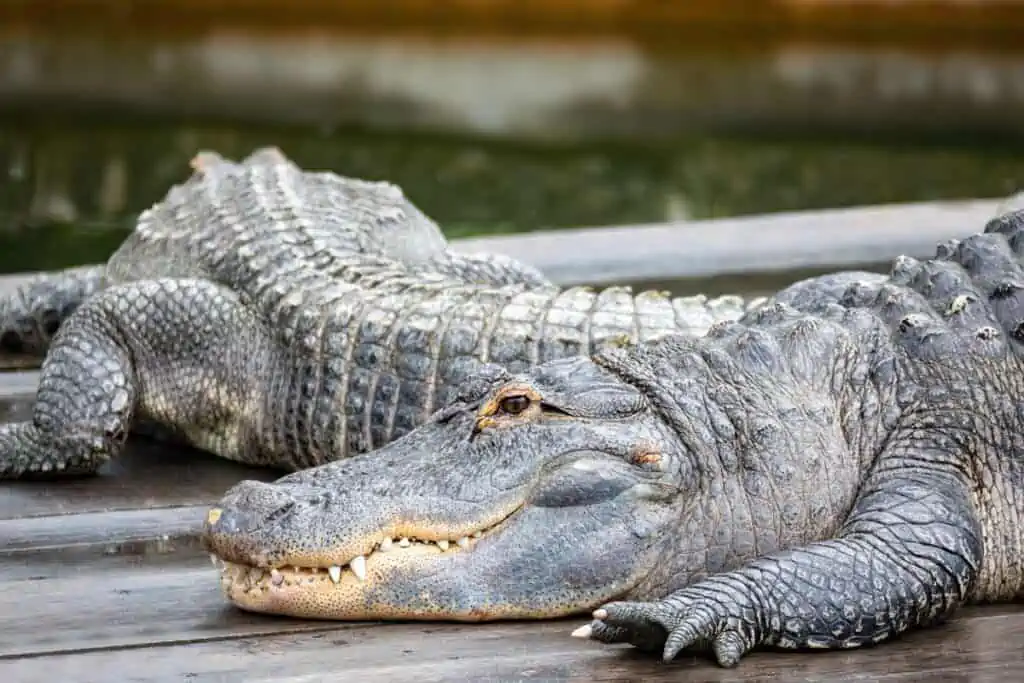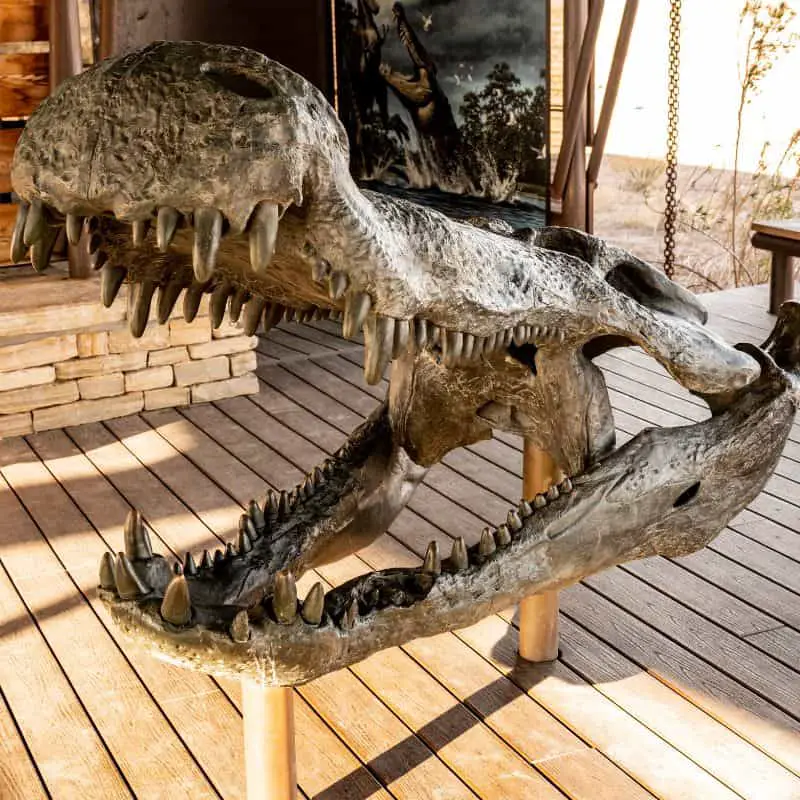Alligators, along with their reptilian cousins like lizards, caimans, and crocodiles, often look like they are related to dinosaurs. You would not be entirely wrong to assume that because alligators lived alongside dinosaurs millions of years ago and share a few similarities. So, are alligators dinosaurs then?
No, alligators are not classified as dinosaurs despite originating from the same reptile group, Archosauria. Fossils indicate that alligators lived before dinosaurs and have adapted to live in harsh conditions, including the unconfirmed events that caused the extinction of dinosaurs.
Behind their prehistoric features, alligators are one of the most advanced reptiles of our time. Alligators differ from other reptiles in that they have a cerebral cortex in their brains, a heart with four chambers, and a diaphragm.
Their physical makeup likely helped their ability to survive better than their giant reptilian counterparts from millions of years ago.

Why Are Alligators Not Considered Dinosaurs?
Alligators share a very distant genetic link to dinosaurs, but they are not classified as dinosaurs for many reasons. Alligators existed before dinosaurs and have outlived them due to their unique physical makeup, intelligence, and hardiness.
Let’s look at their differences to see why alligators are not dinosaurs.
After that, we’ll look at their similarities which often lead us to assume why alligators may be dinosaurs.
Differences Between Alligators And Dinosaurs
Alligators differ from dinosaurs in their appearance, habitats, and definitions. These are some observable differences between alligators and dinosaurs:
- Alligator legs are not beneath their body but sprawl out to the side. An alligator’s thigh bones are almost parallel to the ground, and its gait is side-to-side.
- Dinosaurs stood with their legs directly under their bodies. They could stand upright due to the cavity in their hip sockets. As a result, dinosaurs could run or walk faster and with greater endurance than other reptiles of the same size.
- Alligators are semiaquatic animals, but dinosaurs are terrestrial creatures.
- Not all dinosaurs were carnivorous.
- Alligators have different kinds of teeth to dinosaurs.
- Alligators can go without food for extended periods, which may have helped them to survive the event that caused the extinction of dinosaurs. Alligators store fat in their solid and muscular tails and use it as an energy source.
- Alligators can adapt to different habitats. They can stay in freshwater rivers, lakes, or even dank, festering water if they must.
- Dinosaurs appeared in the Cretaceous Period, while alligators appeared in the Triassic period.
- Dinosaurs are extinct, but alligators continue to dwell on the earth.
Alligators have survived many cataclysmic and harsh events, allowing them to live on earth for over two hundred million years.
This video covers how alligators survived when dinosaurs could not.
Similarities Between Alligators And Dinosaurs
Here are some of the similarities between alligators and dinosaurs that could lead us to ask if they are closely related:
- Both alligators and dinosaurs have large bodies and scaly skin.
- Both alligators and dinosaurs are reptiles, a class of vertebrates. Reptiles are cold-blooded, and most lay eggs.
- Alligators and dinosaurs have four limbs, long tails, sharp teeth, and similar skull shapes.
- They lived during the Mesozoic Era.
- Dinosaurs and alligators are from the clade Archosauria, which means “ruling reptiles“.
- Some prehistoric alligators are extinct, like dinosaurs.
Alligators That Lived Before And Alongside Dinosaurs
During the Triassic Period (around 248 million years ago), Crocodyliformes evolved.
The Crocodyliformes group includes crocodilians and extinct but similar reptiles. From that group, crocodilians appeared during the Cretaceous Period, near the end of the Age of Reptiles (Mesozoic Era).
Three of the fossils that paleontologists discovered stand out in ancient crocodilian ancestry. They are: Thalattosuchia, Deinosuchus, and Baurusuchu.
Thalattosuchia (Thalattosuchia Atavus)
Thalattosuchia lived in the Jurassic Period about 200 to 145 million years ago.
It was 20 feet long, with a long neck, sharp teeth, and webbed feet, and was probably a good swimmer.
Deinosuchus (Deinosuchus Riograndensis)
The name “Deinosuchus” means terrible crocodile. This monster crocodilian grew up to 50 feet long and lived in the late Cretaceous Period, about 146 to 65 million years ago.
The carnivorous Deinosuchus dwelled on the shores of the large, shallow Tethys Sea that covered a large area of Northern America.
Scientists believed it ate fish and maybe some dinosaur species.

Baurusuchu (Baurusuchu Salgadoensis)
Baurusuchu lived in South America in the late Cretaceous Period (100 to 66 million years ago).
It was about 20 feet long and had many features of modern crocodilians.
The First Alligator Species: Brachychampsa
The Brachychampsa genus lived around dinosaurs about 80 million years ago in the Cretaceous period. Paleontologists have discovered their fossils in many parts of the U.S. and Kazakhstan.
It is an extinct alligatoroid genus and is considered an early basal caiman. Brachychampsa is distinguishable from modern alligators by a large fifth tooth in the upper jaw.
Brachychampsa Montana fossils were discovered in Montana’s Hell Creek Formation. Their mouths were more considerable, but their teeth were shorter than modern alligators.
Scientists believe their jaws were much more robust than modern alligators and that they preyed on freshwater turtles, typical fauna living in the creek then.
The classification of Brachycliampsa Montana was described as follows by Charles W. Gilmore in 1911:
- Order: Crocodilia
- Suborder: Eusuchia
- Family: Alligatoridae
- Genus: Brachycliampsa
- Species: Brachycliampsa Montana
What Defines An Alligator And A Dinosaur?
Alligators lived before and during the time of dinosaurs and still live today.
They look pretty prehistoric too.
So why are they not classified as living dinosaurs? Let us look at their two definitions.
The Definition And Order Of Alligators
Alligators are defined as having strong jaws, thick skin, short legs, and an elongated body that includes a long tail.
They are successful predators in water as they tuck in their legs while swimming to reduce resistance in the water.
Alligators have pockets in their upper jaw to accommodate the enlarged fourth teeth on their lower jaws. As a result, unlike crocodiles, you cannot see an alligator’s teeth when its mouth is closed.
Alligators belong to the order Crocodilia but are in the family of Alligatoridae, along with caimans.
You can find alligators in the tropical areas in rivers and marshes of the Southeastern U.S. (Alligator mississippiensis) or their smaller cousins in China (Alligator sinensis).
| Alligator Mississippiensis Quick Facts | |
| Scientific Name | Alligator Mississippiensis |
| Animal Type | Vertebrate, Reptile. Member of the order Crocodilia |
| Animal Family | Alligatoridae (includes caimans) |
| Habitat | United States, Southeastern wetlands |
| Average Length | 6-16 feet. Female alligators are significantly smaller than males. |
| Average Lifespan | Approximately 50 years |
| Conservation Status | Not under threat |
The Definition Of A Dinosaur
Paleontologists defines dinosaurs as extinct animals with upright hind limbs. They flourished on earth during the Mesozoic Era, dating from 252 to 66 million years ago.
Dinosaurs were mostly giant archosaurian reptiles that were either carnivorous or herbivorous.
In 1841, Sir Richard Owen coined the word “dinosaur” to describe these extinct reptiles’ fossils.
The Greek word “deinos” means terrible, and “sauros” means lizards. Thus, according to this moniker, dinosaurs are terrible lizards.

Final Thoughts On Alligators And Dinosaurs
Alligators are not dinosaurs, despite sharing some common characteristics. However, the main reason alligators are not dinosaurs is that they are not extinct.
Alligators have limbs on their sides, while dinosaurs have limbs under their bodies.
Additionally, there are differences in the habitats and eating habits of alligators and dinosaurs.
